FAST DELIVER SERVICE
Shipping & Returns
LOW MOQ
Start your B2B business
STABLE QUALITY
Increased repurchase rate
CUSTOMER CARE
For All Your Questions
Shipping & Returns
Start your B2B business
Increased repurchase rate
For All Your Questions
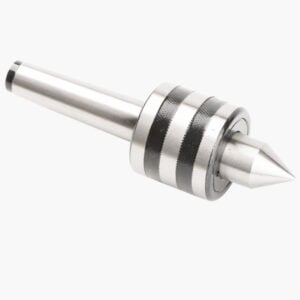
Shipping & Returns
Start your B2B business
Increased repurchase rate
For All Your Questions
Shipping & Returns
Start your B2B business
Increased repurchase rate
For All Your Questions
Shipping & Returns
Start your B2B business
Increased repurchase rate
For All Your Questions
Shipping & Returns
Start your B2B business
Increased repurchase rate
For All Your Questions
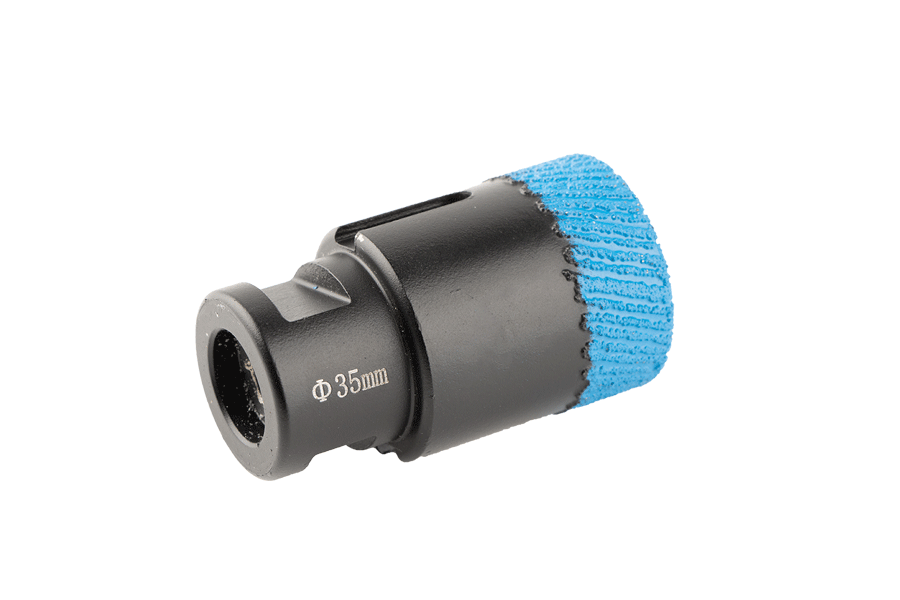
Offer customized solutions, new products, and opportunities to help you explore new markets.
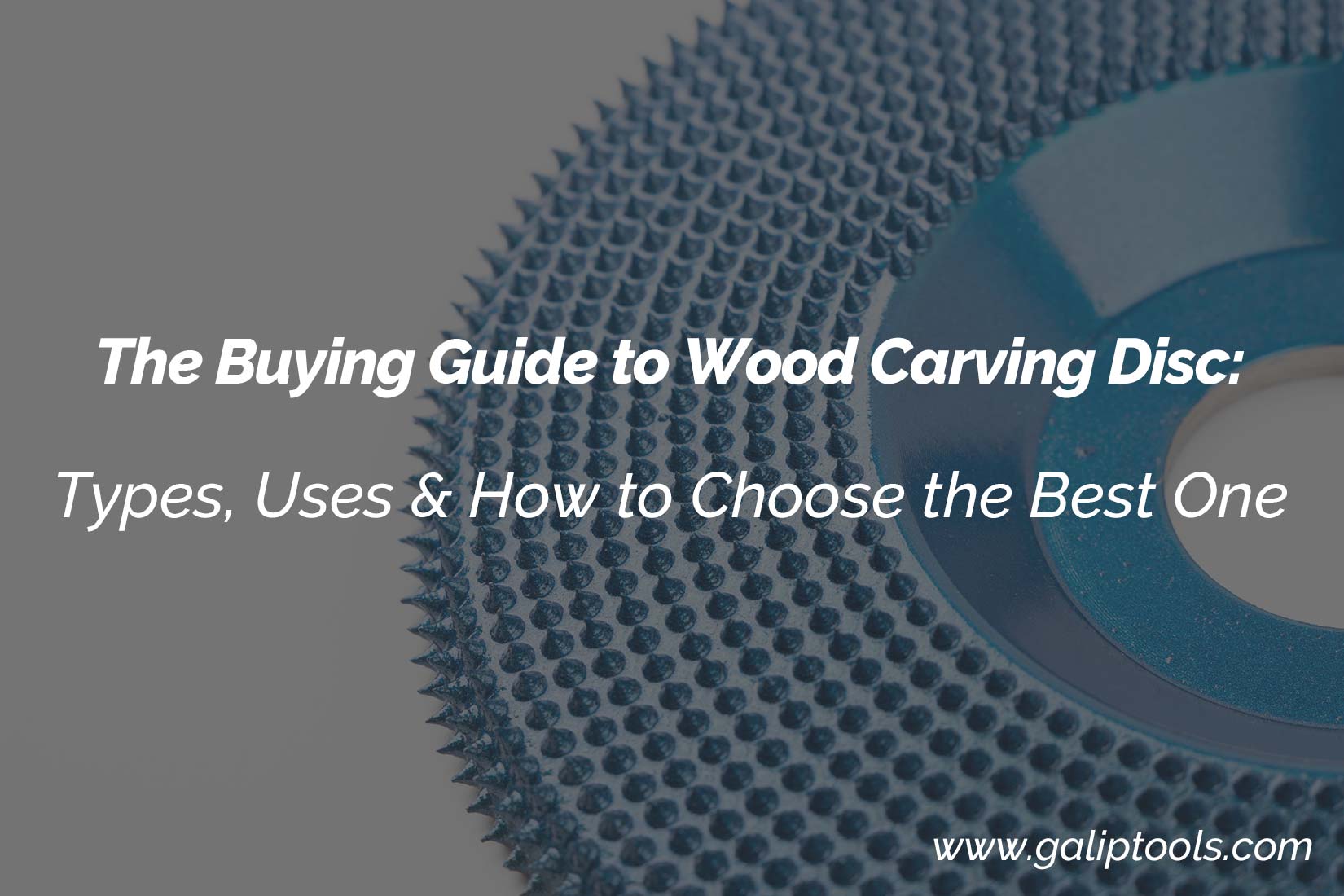
The difference between a masterpiece and a piece of firewood often comes down to one simple, yet crucial choice: the wood carving disc on your angle grinder.
For professionals in the tool industry, whether you’re an engineer by trade or a brand wholesaler by profession, the quality of the components you source is everything. It dictates your customers’ satisfaction, your brand’s reputation, and ultimately, your bottom line. A subpar carving disc doesn’t just mean a poor finish; it means wasted labor, frustrated users, and potential damage to valuable work. This guide is for those who understand that the details matter. We’ll explore the tools of the trade, not just from a user’s perspective, but from a business and engineering standpoint.
| Your Goal | Recommended Disc Type | Best For... |
|---|---|---|
| General Purpose Smoothing | Flat Ordinary Disc (Manganese Steel) | Leveling planks, removing bark, basic surface prep on softwoods. |
| Carving & Shaping | Round (Convex) or Carbide Disc | Creating concave shapes like bowls, spoons, and organic sculptures. |
| Heavy-Duty Stock Removal | Tungsten Carbide Disc | Aggressively shaping hardwoods, fast material removal, high durability. |
| Edge & Detail Work | Oblique (Angled) Disc | Beveling edges, trimming corners, working in tight spaces. |
| Sourcing for Longevity & ROI | Tungsten Carbide Disc | Wholesalers who need to provide durable, high-performance tools that minimize returns. |
Let’s be honest. In the world of power tools, the humble carving disc is often an afterthought. It’s a consumable, something you throw away and replace. But what if that perspective is costing you? For a seasoned woodworker, a construction professional, or even a dedicated DIYer, the specific disc you clamp onto your angle grinder is the very point of contact where intention becomes reality. It’s the difference between a smooth, flowing curve and a jagged, gouged-out mess.
Using the wrong disc is like trying to paint a fine portrait with a house roller—sure, you’ll get paint on the canvas, but the result won’t be what you envisioned. It leads to rough finishes, frustrating rework, and accelerated wear on both the wheel and the grinder itself. This guide is designed to cut through the noise. We’re going to walk through the main types of wood carving discs, explain how their material and design impact performance, and help you determine precisely which disc is right for any given job. If you’ve ever found yourself wondering, “What’s the real performance difference between carbon steel and manganese steel?”, “What kind of wheel should I use for bowl carving?” or “Are tungsten carbide discs truly worth the premium for my inventory?”—then you’re in exactly the right place.
Understanding the type of a wood carving disc is the first step toward making an informed choice. They aren’t one-size-fits-all. The material, the shape, and the tooth design are all engineered for different purposes. The right choice hinges on three things: the wood you’re working with, the finish you need, and the tool in your hands.
Ordinary discs are the go-to for a wide range of basic wood preparation and shaping tasks. They are typically made from either manganese steel or high-carbon steel, making them a cost-effective choice for working on soft to moderately hard materials. Beyond wood, they’re also handy for things like cork, plastic, or even rubber.
They generally come in three fundamental shapes:
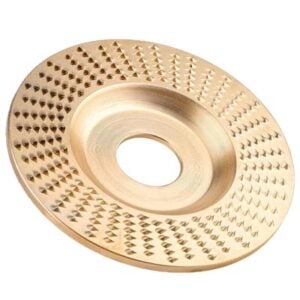
Best for: Grinding and smoothing large, flat surfaces.
Application: Perfect for leveling hardwood and softwood planks, removing old paint or varnish, or cleaning up saw marks, bark, and more.
Pros: Highly stable, generally affordable, and easy to control for a consistent finish on flat planes.
Cons: Not suited for carving or working on any kind of contoured surface.
Flat discs excel when you need consistent material removal across broad surfaces. Think of them as the reliable sedan of grinding discs — not flashy, but they get the job done efficiently.
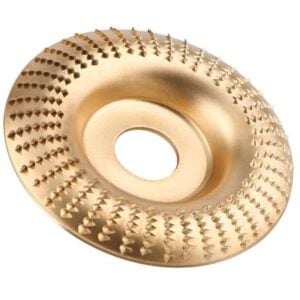
Best for: Bowl carving, scooping, and aggressive contour shaping.
Application: The MVP for creating concave surfaces. Think wooden bowls, large spoons, or custom chair seats.
Pros: Allows for incredibly smooth transitions between shapes and gives you precise control over curved cuts.
Cons: Far less effective on flat surfaces; it’s a specialist tool.
Round discs are where the magic happens for artistic woodworking. They follow natural curves beautifully, allowing you to create flowing, organic shapes that would be impossible with flat discs.

Best for: Edge work, beveling, chamfering, and intricate angled cuts.
Application: Excellent for detailed trimming, shaping the corners of furniture, effortlessly level high spots, or adjust uneven surfaces.
Pros: Unmatched access and versatility for complex shapes.
Cons: It requires a steady hand. The angled profile can be aggressive, so it takes some practice to achieve clean finishes.
A Word on Materials: Manganese Steel vs. Carbon Steel
This is where we get into the engineering. For a wholesaler, knowing the difference is key to stocking the right products.
Carbon Steel: This is your baseline. It’s relatively inexpensive and can achieve excellent hardness after a proper heat treatment, resulting in a sharp cutting edge. For occasional use or budget-conscious buyers, carbon steel discs deliver solid performance without the premium price tag. However, that sharpness can come at the cost of durability—it tends to wear down more quickly, especially under heavy use.
Manganese Steel Is another good choice. From our testing and experience, manganese steel is the superior material for durability. Why? The high manganese content creates an alloy with exceptional wear resistance. During production and heat treatment, we can use a slower cooling oil, which reduces deformation and cracks caused by drastic temperature drops during manufacturing. This results in a disc that has higher strength and hardness than its carbon steel counterpart. It can withstand more force, so the cutting edges stay effective for much longer. Honestly, in our lifespan tests, a well-made manganese steel disc consistently outlasts a carbon steel one, and it even offers a bit more corrosion resistance. The tradeoff? It’s a more difficult material to process, which translates to a slightly higher cost. But the return on investment, in terms of longevity, is undeniable.[1]
When you move from general work to high-demand applications, you enter the realm of carbide. These discs feature teeth made from tungsten carbide, one of the hardest materials used in cutting tools. They represent a significant leap in both performance and durability, especially on tough hardwoods.
Key Features:
“For any professional or serious hobbyist, a carbide disc isn’t a luxury; it’s a productivity tool.”
Beyond the main carving discs, a well-stocked workshop might include these complementary tools:
Flap Discs: Composed of overlapping abrasive flaps, they are fantastic for blending, sanding, and finishing work.
Chain Discs: Essentially a small chainsaw blade on a disc. Incredibly powerful for extreme shaping and log debarking, but they demand the utmost respect and caution.
Sanding Pads: For the delicate final stages of finishing.
Polishing Wheels: Used with a polishing compound to bring the wood to a smooth, almost mirror-like sheen.
Think of these not as replacements, but as the next steps in your workflow after the main grinding is done.
Alright, let’s make this practical. Choosing the right disc isn’t an abstract exercise; it’s a decision that impacts your efficiency, your final product, and your budget. Here’s a checklist an engineer would appreciate.
✅ Match the Material & Its Condition
This seems obvious, but the details matter.
Softwoods (Pine, Cedar, Fir): An ordinary steel disc is usually perfectly adequate.
Hardwoods (Oak, Walnut, Maple): Don’t hesitate. A carbide disc will perform better, last longer, and save you headaches.
Non-Wood Materials (Plastic, Rubber, etc.): An ordinary disc and a carbide disc both work well.
Wood Condition: Here’s a pro tip—consider the moisture content. Is the wood freshly cut or kiln-dried? Fresh, wet wood contains more moisture and resin, which can cause discs to clog more quickly. The long, stringy fibers of wet wood can also tear rather than cut cleanly. A disc with deeper grooves or long teeth, like some carbide models, can help clear this damp material more efficiently.
✅ Match the Tool
This is non-negotiable. Always ensure the disc is fully compatible with your angle grinder. Check the three key specs:
Disc Diameter: Most common angle grinders use 4.5-inch or 5-inch discs.
Arbor Size: This is the size of the mounting hole. It must match your grinder’s spindle.
RPM Limit: Every disc has a maximum safe speed. Ensure your grinder’s RPM does not exceed the disc’s limit. Nothing ruins a project faster than a disc that doesn’t fit properly or exceeds your grinder’s capabilities.
✅ Define Your Task Clearly
Just smoothing a surface? Go with a flat disc. It’s the right tool for the job.
Sculpting or serious shaping? You’ll want the control of a round (convex) disc or the raw power of a carbide disc.
Trimming edges, doing joint work, or leveling high spots? An angled (oblique) disc will give you the access you need.
✅ Factor in the Business Case (Budget vs. Value)
For occasional or light-duty work: An ordinary steel disc is a perfectly cost-effective choice.
For long-term value and professional use: A carbide disc is an investment. The higher upfront cost is easily paid back in longevity and efficiency, especially for a business that can’t afford downtime. Also don’t forget the total cost of ownership.
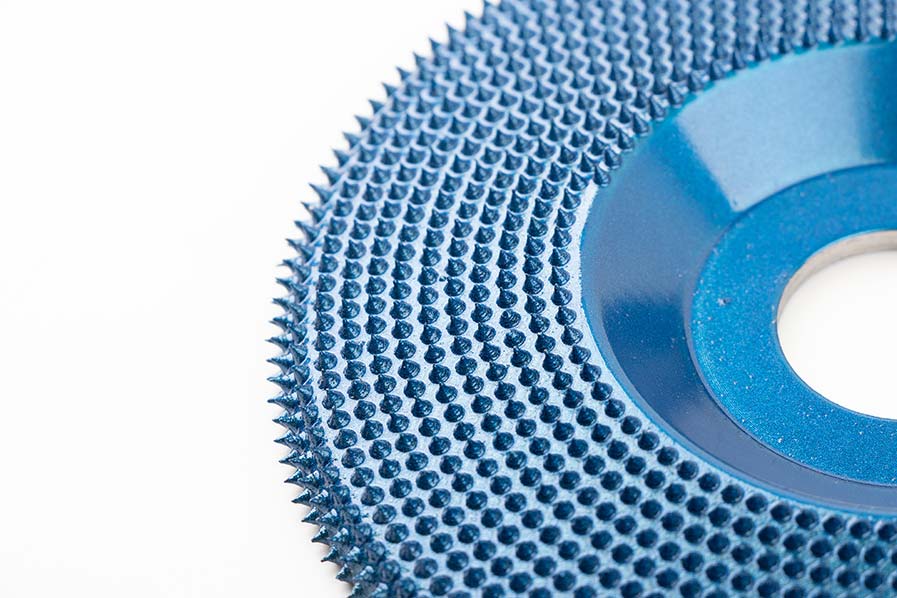
At Galiptools, we aren’t just selling this; we’re a supplier with deep experience in tool manufacturing. We live and breathe this stuff. And that’s why we’re introducing our carbide woodworking discs, engineered for professionals and wholesalers who demand superior performance without the exorbitant price tag.
We pay close attention to the global tool market. A recent analysis of the German market—arguably one of the most sophisticated and demanding in Europe—revealed some clear trends. Professionals there are demanding:
Discs with a significantly longer operational lifespan.
Faster, more aggressive stock removal on hardwoods.
Better, cleaner performance in bowl and curve shaping applications.
Product certification requirements such as MPA
We saw that while popular high-end brands deliver on performance, their price point is often difficult to justify. There is a clear and growing gap in the market between premium price and reliable, day-in-day-out performance.
We make this disc. Here’s how:
Premium Tungsten Carbide Teeth: We source high-grade carbide that resists dulling and fracturing, ensuring a long and predictable service life.
Optimized Bowl-Fit Design: The curvature and tooth placement are computer-modeled for clean, efficient material removal in concave applications. No more gouging or uneven surfaces.
Anti-Clogging Grooves: The channels between the teeth are designed to expel wood chips and resin efficiently, preventing buildup that leads to overheating and poor performance.
Competitive Pricing with Top-Tier Durability: We control the quality and the cost. We offer performance that competes with the top brands at a price that makes sense for your business.
Universal Fit: Designed to be compatible with the vast majority of standard angle grinders on the market.
Our product isn’t another cheap alternative. It’s the intelligent choice for wholesalers and professionals who understand that true value lies in performance and reliability, not just a brand name.
| Feature | Ordinary Steel Disc | Galiptools Carbide Disc |
|---|---|---|
| Primary Use | General smoothing, softwood shaping | Aggressive shaping, hardwood carving |
| Material | Manganese or Carbon Steel | Tungsten Carbide |
| Lifespan | Good (several hours of use) | Exceptional (weeks or months of use) |
| Speed | Moderate | Very Fast |
| Best for Hardwood | Acceptable, but wears quickly | Excellent |
| Best for Bowl Carving | Good (with round shape) | Superior |
| Upfront Cost | Low | Medium-High |
| Long-Term ROI | Good for hobbyists | Excellent for professionals/business |
Before we wrap up, let’s talk seriously about safety. An angle grinder spinning a wood carving disc is an incredibly aggressive tool. It removes wood at a phenomenal rate, and that power demands your full attention and respect. Don’t let your guard down.
First, use the right tool for the job. Your angle grinder should have modern safety designs. If possible, use one with a shock-absorbing auxiliary handle and a stuck-rebound protection device that cuts power if the disc binds. And let’s be crystal clear: It is forbidden to install a woodworking saw blade on an angle grinder. Period. That is a recipe for disaster.
When you’re carving, your personal protective equipment (PPE) is non-negotiable.
Wear a full protective face shield or transparent eye mask, not just safety glasses.
Do NOT wear knitted gloves. If a glove catches on the spinning disc, it can pull your hand in.
Do NOT wear loose-fitting clothes. Tie back long hair and make sure the cuffs of your shirt are buttoned tightly.
Consider using a saber saw or curved saw for certain applications instead
Fix the material you are grinding securely. Don’t try to hold it with one hand while grinding with the other.
Make sure the angle grinder’s protective guard is installed correctly. It’s there for a reason.
Before you start, check the condition of the disc and the grinder. Pay attention to the rotation direction of the grinder and position yourself. Ensure you’re positioned slightly off one side of the machine and let the sparks fly towards you. When grinding and engraving, never place your body on the grinding path.
Finally, avoid long-term fatigue work. Take breaks. Using a powerful tool with one hand is a sign that you’re tired and getting careless.
Remember: No project is worth an injury. Take your time, use proper safety equipment, and don’t rush.
Q: Can you use a metal shaping disc on wood?
A: You really shouldn’t. It’s not recommended. Metal shaping discs are designed to abrade metal; on wood, they tend to burn and clog rather than cut. This can scorch the wood, create a lot of smoke, and pose a significant safety risk from kickback. Always use discs specifically designed for wood.
Q: How long does a wood carving disc actually last?
A: It varies wildly depending on the disc material, the type of wood, and how aggressively you use it. An ordinary steel disc might last for several hours of moderate use on pine. A high-quality carbide disc, used on the same material, could last for weeks or even months of daily professional work.
Q: What size carving disc should I use?
A: You must match the disc size to your tool’s specifications. The most common sizes for handheld angle grinders are 4.5 inches (115mm) and 5 inches (125mm). Using a disc that is too large can throw the tool off balance and exceed its safety ratings.
Q: Are carbide discs really worth the extra cost?
A: Honestly, yes—if your work demands it. If you regularly work with hardwood, need to remove material quickly, or do frequent shaping and carving, the initial investment in a carbide disc pays for itself many times over in terms of lifespan, efficiency, and the quality of the finish.
At the end of the day, choosing the right wood shaping disc is about pursuing better results, ensuring safer operation, and making smarter business decisions. A better disc leads to less waste, faster project completion, and happier customers. Whether you’re flattening a massive slab of oak, shaping an elegant bowl, or refining a delicate curve, there’s a disc specifically engineered for your task.
Stop settling for “good enough.” Equip yourself or your customers with a tool designed for performance and longevity.
Looking for a durable, high-performance shaping solution that offers an incredible return on investment?
👉 Check out the Galiptools carbide carving disc collection now and experience the fast speed removal.
Need to discuss wholesale pricing or have a technical question?
📞 Contact our expert team today. We’re here to help you find the perfect solution for your needs.
No account yet?
Create an Account